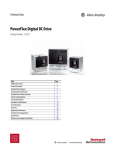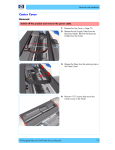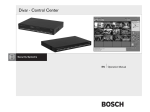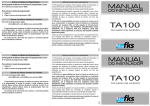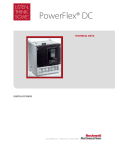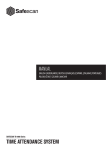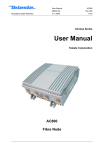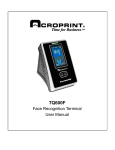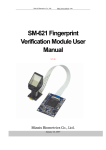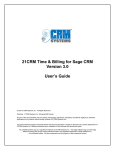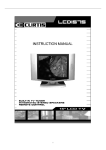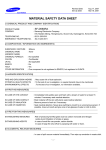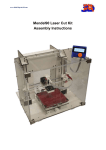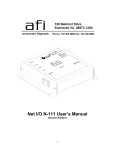Download FINGERTEC® TECHNICAL TRAINING
Transcript
FINGERTEC® TECHNICAL TRAINING Introduction Biometrics refers to two very different fields of study and application. The first, which is the older and is used in biological studies, including forestry, is the collection, synthesis, analysis and management of quantitative data on biological communities such as forests. Biometrics in reference to biological sciences has been studied and applied for several generations and is somewhat simply viewed as "biological statistics." More recently and incongruently, the term's meaning has been broadened to include the study of methods for uniquely recognizing humans based upon one or more intrinsic physical or behavioral traits. FingerTec® system is using fingerprint as main enrollment and verification method. Fingerprint is the most convenience physiological identities among all. During fingerprint capturing, FingerTec® terminal is capturing the minutia points of fingerprint, instead of image. The three basic patterns of fingerprint ridges are the arch, loop, and whorl. An arch is a pattern where the ridges enter from one side of the finger, rise in the center forming an arc, and then exit the other side of the finger. Copyright 2008 FingerTec Worldwide Sdn. Bhd. All rights reserved. FINGERTEC® TECHNICAL TRAINING The loop is a pattern where the ridges enter from one side of a finger, form a curve, and tend to exit from the same side they enter. In the whorl pattern, ridges form circularly around a central point on the finger. Scientists have found that family members often share the same general fingerprint patterns, leading to the belief that these patterns are inherited. The major Minutia features of fingerprint ridges are: ridge ending, bifurcation, and short ridge (or dot). The ridge ending is the point at which a ridge terminates. Copyright 2008 FingerTec Worldwide Sdn. Bhd. All rights reserved. FINGERTEC® TECHNICAL TRAINING Bifurcations are points at which a single ridge splits into two ridges. Short ridges (or dots) are ridges which are significantly shorter than the average ridge length on the fingerprint. Minutiae and patterns are very important in the analysis of fingerprints since no two fingers have been shown to be identical. The fingerprint capturing mechanism is as below, Captured and converted into minutiae points Original fingerprint Copyright Fingerprint templates 2008 FingerTec Worldwide Sdn. Bhd. All rights reserved. FINGERTEC® TECHNICAL TRAINING During verification process, fingerprint captured is converted into fingerprint templates. Verification is done by comparing the captured fingerprint template with the stored fingerprint templates. The fingerprint templates cannot reverse to gain the orgininal fingerprint images. Therefore there are no worries for the system or other users to “steal” your unique fingerprint and use it for any other purpose. The Main Functions of FingerTec® Terminals FingerTec® offers several models with different outlook and functions. Basically there are 2 groups of products, which are 1 – for time attendance only 2 – for time attendance and access control The workflow is as below, 1. User place finger on scanner. 2. Fingerprint captured and converted into templates. 3. System verifies users’ identities. 4. Date and time during verification is recorded as Transaction Log. Transaction logs are downloaded into TCMS V2 software as displayed as attendance records. 5. Door opened for users For terminal with time attendance function only, the process starts from step 1 to step 4. Step 5 is only available for terminal with time attendance and access control functions. Therefore terminal with time attendance and access control functions can be installed as time attendance unit by ignoring the door lock system. Copyright 2008 FingerTec Worldwide Sdn. Bhd. All rights reserved. FINGERTEC® TECHNICAL TRAINING Chapter 1 1.1 Basic operations Users’ Privilege For all models (except i-Kiosk 100 series), there are 3 levels of users’ privileges, which are supervisor, admin and users. There are differences for users’ privilege. The highest authorities is Supervisor, followed by Admin, and lowest is users. Functions available Clear all data Clear attendance data Delete user Reset to default settings Configure matching threshold Enable/Disable voice greeting Enable/Disable card verification Enable/Disable Antipassback Enable/Disable WorkCodes Change Date/Time Change Languages Change communication settings Change power on/off settings Check device storage and information Enroll new users Enroll new Admin Enroll new supervisor Verify to report attendance or gain access Supervisor Yes Yes Yes Yes Yes Yes Yes Yes Yes Yes Yes Yes Yes Yes Yes Yes Yes Yes Admin User Yes Yes Yes Yes Yes Yes Yes Yes Yes Therefore it is advisable to assign a trust worthy person as Supervisor to take control of the system. Please always request Supervisor to clear admin privilege if he/she is no longer to take control of the system. Please refer the hardware user manual and VCD for more details for each model. The enrollment of supervisor or admin can be done at the terminal during first enrollment. Anyway there is alternative to change users privilege by using FingerTec® TCMS V2 software. This alternative is easier compare to enrollment. Please refer to the FingerTec® TCMS V2 software manual and VCD for more details. For i-Kiosk100 series models, the privilege of Admin is same as Supervisor. Therefore there are only 2 levels of privilege in i-Kiosk 100 series models, which are Admin and Users. Therefore in i-Kiosk 100 and i-Kiosk 100Plus, Admin is the highest authorities, similar to Supervisor. 1.2 Enrollment & Verification There are 4 types of enrollment methods in FingerTec® terminals, which are fingerprint, password, MIFARE card, and RFID card. The types of enrollment and verification methods for all models are as below, Copyright 2008 FingerTec Worldwide Sdn. Bhd. All rights reserved. FINGERTEC® TECHNICAL TRAINING AC100 AC103-R TA100 TA103-R AC100Plus AC800 AC800Plus AC800Plus MC AC900 M2 R2 R2 MIFARE iKiosk 100 i-Kiosk 100Plus TimeLine Kadex 1.2.1 Fingerprint Password Yes Yes Yes Yes Yes Yes Yes Yes Yes Yes Yes Yes Yes Yes Yes Yes Yes Yes Yes Yes Yes Yes Yes Yes Yes Yes Yes MIFARE card RFID card Different verification Yes Yes Yes Yes Yes Yes Yes Yes Yes Yes Yes Yes Yes Yes Yes Yes Yes Yes Fingerprint Fingerprint enrollment is the most general method to register at the terminal. As discussed before, enrollment of fingerprint is converting the original image into templates to store inside terminals. Therefore the types of scanner are affecting the capturing image, and its converted templates. Furthermore the differences of types of scanners are as below, Response time interval Quality of image capture Power consumption Cost Optical scanner Medium Normal High Low URU scanner Medium Good Normal Normal UPEK scanner Fast Best Low High Please refer to the hardware user manual and VCD for more details in fingerprint enrollment and verification. During enrollment, please kindly take note of the followings, 1 – Finger to use to enroll into terminals. It is recommended to use index fingers to enroll to terminal. Some users might have bigger thumb and it is difficult for them to place fingers on the scanner. 2 – Quality of fingerprint. Check the user’s fingerprint before enrollment. Make sure the fingerprint is clear and without any cut or wound. Please advice users to use another fingers to do enrollment. Users with blur fingerprints, or cut wound is not advisable to enroll by using optical scanner. URU scanner is another suggestion to overcome this. UPEK scanner, which scans the inner layer of finger, can capture any kinds of fingerprints. 3 – Proper enrollment method. Please refer to the hardware user manual and user self learn VCD to learn proper enrollment method. Copyright 2008 FingerTec Worldwide Sdn. Bhd. All rights reserved. FINGERTEC® TECHNICAL TRAINING 1.2.1.1 1 to many matching method For fingerprint verification, there are 2 types of operations, either “1 to many” or “1 to 1”. In “1 to many”, user will only place finger on the scanner. Terminal captures fingerprint image and convert into templates. The system will search and compare the templates with those stored in memory. Captured and converted into minutiae points 1.2.1.2 Searching into memory for matched templates Please try again User ID 000012 Henry Verified If failed to verified If successes ? 1 to 1 matching method For “1 to 1”, user must enter user ID and then place finger on scanner. Terminal automatic search the stored fingerprint templates for the entered user ID. The fingerprint template is ready and awaiting to compare with the input fingerprint template. User places finger on scanner to capture fingerprint. Fingerprint then converted into fingerprint templates and compare with ready fingerprint templates. User enter user ID Searching into memory for the user ID’s template User ID 000012 Captured and converted into minutiae points Verification process running Henry Verified In term of speed, “1 to many” matching method is faster than “1 to 1”. In this method, user does not enter any user ID but only place finger on the scanner. The system captures, search and verified the users. Anyway the system takes longer time if 1 – the total fingerprint templates stored exceeding 50% of the total. System needs to spend more time to search in a larger database. 2 – the users with poor quality fingerprint. The captured fingerprint template is not clear and therefore affecting the searching speed. Copyright 2008 FingerTec Worldwide Sdn. Bhd. All rights reserved. FINGERTEC® TECHNICAL TRAINING Under these 2 conditions, it is recommended to use “1 to 1” matching method. The system can directly look for fingerprint templates for a user after receiving user ID. The verification process is started when user place finger on the scanner. By default, every FingerTec® terminal supports both “1 to many” and “1 to 1” matching method. Anyway you can disable the 1 to many methods by configuring the setting in terminal. The terminal will not capture fingerprint when user place finger on scanner. 1.2.2 Password It is recommended for uses to enroll with password if cannot enroll with fingerprint (disable, poor quality fingerprint etc). FingerTec® terminal can support up to 5-digits password. Each user is entitling to 1 password only, and password can be changed. Password user must enter user ID and follow by password to verify identity. For both i-Kiosk 100 and i-Kiosk 100 Plus, the maximum password length is 8-digits. Please refer to the hardware user manual and VCD for more details in password enrollment and verification. Beside to enroll password in terminal, password can register at the TCMS V2. Password can upload from TCMS V2 to the terminal. Please refer to the FingerTec® TCMS V2 software manual and VCD for more details. 1.2.3 Card Some of FingerTec® terminals can read and verify users via cards. The terminals can support either MIFARE cards or RFID cards. 1.2.3.1 MIFARE card MIFARE card is card to store user information including fingerprint templates. For FingerTec® terminals model AC800Plus MC and R2 MIFARE, terminal can read and write the user’s fingerprint templates into the card, but not the others information. Every time user will bring the MIFARE card and wave it to terminal, so terminal will read the fingerprint templates from card. The user places finger on the scanner to capture his fingerprint to verify with fingerprint templates captured from card. Users can choose not to store his/her fingerprint templates in the terminals. Therefore user must always carry the MIFARE card to verify at the terminals. In this scenario, the terminal can supports up to 4000 cards (users). User waves MIFARE card to terminal Fingerprint templates captured into memory of terminal Captured and converted into minutiae points User ID 000012 Verification process running Henry Verified Copyright 2008 FingerTec Worldwide Sdn. Bhd. All rights reserved. FINGERTEC® TECHNICAL TRAINING The technical specifications of MIFARE card is as below, Philips MIFARE S50 or S70 Memory: 1K (S50), 4K(S70) Operating Frequency: 13.56MHz Transmission Speed: 106kbit/s Operating Distance: 2.5-10cm Operating Temperature: -20-85 (Celsius) Differences of MIFARE card with S50 and S70 chipset S50 S70 Memory size 1k 4k Fingerprint storage 4 templates 10 templates Please see hardware user manual and VCD for more details in MIFARE card enrollment and verification. Sample of MIFARE card By default, terminal is reading the content of MIFARE card to verify user, without requesting the fingerprint from the users. This is an optional setting, and terminal can be configure to read both content of MIFARE card and user’s fingerprint. You can configure this in Advance Option > Read Card only > Yes/No Read card only Yes No 1.2.3.2 Operation of terminal Terminal will only read content of MIFARE to verify the user. Terminal will read content of MIFARE card and user’s fingerprint to verify the user RFID card RFID card is a radio frequency identification card, which storing card ID only. The card ID is a 10-digits number printed on the surface of the card. FingerTec® models supporting RFID card function are including AC103-R, TA103-R, R2, i-Kiosk 100 and i-Kiosk 100 Plus, Kadex and TimeLine. Copyright 2008 FingerTec Worldwide Sdn. Bhd. All rights reserved. FINGERTEC® TECHNICAL TRAINING Sample of RFID card. You will see there are 3 sets of numbers printed on the surface of card, example 0001747879, 026, 43943. FingerTec® terminals will only read number A (0001747879) as RFID card number, but not the number B or C. The relationship of A, B and C is as below, A = B * 65536 + C Example Number printed on RFID Card = 0001747879, 026, 43943 A = 1747879, B = 26, C = 43943 As calculate, A = (26 x 65536) + 43943 = 1747879 When user wave RFID card to the terminal, terminal will read Card ID from it. Terminal will search into memory for user ID pairs with the Card ID. The fingerprint templates for the user ID is from memory and user place finger to verify. This scenario is similar to “1 to 1” matching, but user does not physically enter the user ID. User wave RFID ID card to the terminal Searching into memory for the user ID’s template User ID 000012 Captured and converted into minutiae points Verification process running Henry Verified The terminal is storing users’ fingerprint templates and Card ID. Therefore user must verify by RFID card and fingerprints. Anyway terminal can be configured to verify by reading users’ RFID card only. The technical specifications of RFID card is as below, Card Type: Code: Resonance Frequency: Card Operating Temperature: Card reading distance: EM RFID card 64 bits 125kHz -10 ~ 50 Celsius 0~5 cm Please see hardware user manual and VCD for more details in RFID card enrollment and verification. Copyright 2008 FingerTec Worldwide Sdn. Bhd. All rights reserved. FINGERTEC® TECHNICAL TRAINING 1.2.4 Different Verification Method As described before, few models of FingerTec® terminals can support different verification. In these terminals, users divided into 5 groups and each group of users verifies by combinations of 2 to 3 verification methods. Example Users in Group 1 – verify by using fingerprint only Users in Group 2 – verify by using fingerprint + password Users in Group 3 – verify by using password + RFID card There are total of 15 types of combinations available to choose to assign to each group. You can use FingerTec® TCMS V2 software to configure to assign users into group, and to assign the combination of verification methods to the groups. The details of verification methods are as below, Type of verifications FP / PW / RF FP PIN PW RF FP / PW FP / RF PW / RF PIN & FP FP & PW FP & RF PW & RF FP & PW & RF PIN & FP & PW FP & RF / PIN Operations Reader verifies Reader verifies Reader verifies Reader verifies Reader verifies Reader verifies Reader verifies Reader verifies Reader verifies Reader verifies Reader verifies Reader verifies Reader verifies Reader verifies Reader verifies matching. Copyright users users users users users users users users users users users users users users users via fingerprint, password or RFID card. via fingerprint only. via User ID only. via password only. via RFID card only. either via fingerprint or password. either via fingerprint or RFID card. either via password or RFID card. via 1:1 fingerprint matching only. via fingerprint with password only. via fingerprint with RFID card only. via password with RFID card only. via fingerprint + password + RFID card. via User ID + fingerprint + password. either via fingerprint + RFID card or 1:1 fingerprint 2008 FingerTec Worldwide Sdn. Bhd. All rights reserved. FINGERTEC® TECHNICAL TRAINING Chapter 2 Communication Settings There are total of 6 types of communication methods available in FingerTec® terminals, which are TCP/IP, RS23, RS485, USB flash disk (pen drive), Wiegand 26-bits input and Wiegand 26-bits output. Anyway some communication option might not available in some models. Please check the table below. AC100 AC103-R TA100 TA103-R AC100Plus AC800 AC800Plus AC800Plus MC AC900 M2 R2 R2 MIFARE iKiosk 100 iKiosk 100Plus TimeLine Kadex Kadex U 2.1 26-bits Wiegand Input 26-bits Wiegand Output TCP/IP RS232 RS485 USB flash disk Yes Yes Yes Yes Yes Yes Yes Yes Yes Yes Yes Yes Yes Yes Yes Yes Yes Yes Yes Yes Yes Yes Yes Yes Yes Yes Yes Yes Yes Yes Yes Yes Yes Yes Yes Yes Yes Yes Yes Yes Yes Yes Yes Yes Yes Yes Yes Yes Yes Yes Yes Yes Yes Yes Yes Yes Yes Yes Yes Yes Yes Yes Yes Yes Yes Yes Yes Yes Yes Yes Yes Yes Yes Yes Yes Yes Yes Yes Yes Yes TCP/IP The most common communication method to connect to FingerTec® terminals. All terminals can support TCP/IP connections. In terminals, these are the important settings in communication option (COMM Opt), IP address NetMask GateWay Netspeed Dev num Functions To assign an IP address to the terminal, so software can connect to the terminal. Example 192.168.1.201 NetMask settings to suit into the network envionment. Ignore if you are connecting direct from 1 computer to 1 terminal. Example 255.255.255.0 Gateway settings to suit into network environment. Ignore if you are connecting direct from 1 computer to 1 terminal. Example 192.168.1.1 Network speed of the network environment, recommeneded AUTO. The number of device, range from 1 to 255. Copyright 2008 FingerTec Worldwide Sdn. Bhd. All rights reserved. FINGERTEC® TECHNICAL TRAINING 2.1.1 Configurations of network cables and their connections There are 2 types of configurations of network cable, which are straight-T and cross-link. The difference is the arrangement of whips inside the cable. There are 8 whips inside a network cable and each with different color to indicate their position. If the RJ45 jacks for both ends are with same whips positioning, this is a straight-T network cable. Straight-T network cable suitable to use to connect into network switches, and it is widely used in a network environment. Straight-T Network cables Copyright 2008 FingerTec Worldwide Sdn. Bhd. All rights reserved. FINGERTEC® TECHNICAL TRAINING If the RJ 45 jack for both ends are different in whips arrangement, then it is called cross-link network cable. Please see its configuration for both RJ45 jacks as below, RJ45 Jack A RJ45 Jack B Orange stripe Green stripe Orange Green stripe Blue Green Orange stripe Blue Blue stripe Blue stripe Green Brown stripe Orange Brown Brown Brown stripe Cross-link network cable is used when 1 terminal is connecting directly into a computer. Cross-link Network cables 2.1.2 To check the connection from computer to the terminal The simplest method to check the connectivity of terminal and computer is to use “ping command”. The steps are 1 – Press “Windows Start” button 2 – Select “Run”. 3 – Enter “cmd” and press enter. 4 – In DOS command page, enter “ping IP address of the terminal”, example “ping 192.168.1.168” and press enter. Copyright 2008 FingerTec Worldwide Sdn. Bhd. All rights reserved. FINGERTEC® TECHNICAL TRAINING 5 – If the terminal is connected, these will be showed on screen. Now you can run FingerTec® TCMS V2 and to connect to this terminal. If FingerTec® TCMS V2 software cannot connect to the terminal, there are IP address conflict. Please confirm the IP address of the terminal is not same as other devices or computers in the network environment. If this is the result after entering the “ping command”, it means terminal is not connected. Please kindly recheck the settings and types of cables. Copyright 2008 FingerTec Worldwide Sdn. Bhd. All rights reserved. FINGERTEC® TECHNICAL TRAINING 2.2 RS232 cable RS232 cable is the easiest way for reader to communicate with computer. By lugging in the RS232 cable to computer, reader could communicate with computer. No other special device is required. It is also the most cost saving method. The RS232 cable used for installation could not exceed 3 meters. For few FingerTec® models, you cannot plug the RS232 cable directly because the terminals do not equipped with the 9-pins serial port. These models are AC800Plus, AC800PlusMC, AC900, M2, R2, iKiosk 100 and i-Kiosk 100Plus. You will need to prepare the connecting cable, and make use of RX, TX and GND at the back of terminal. For AC900 The connection diagram is as below, For M2, R2, i-Kiosk 100, Kadex Copyright 2008 FingerTec Worldwide Sdn. Bhd. All rights reserved. FINGERTEC® TECHNICAL TRAINING The connection diagram is as below, For other models, AC100 series, TA100 series and TimeLine, they are equipped with 9-pins serial port. You can plug the RS232 cable directly. You will need to configure the settings in communication option (COMM Opt) as below, Dev num Baud rate RS2332 RS485 Functions The number of device, range from 1 to 255. To configure the data transfer speed, recommended 115200 To enable/disable RS232 connection, turn to Y To enable/disable RS485 connection, turn to N. If connection between reader and computer is failed, it is difficult to identify the factor. Even if this is the easiest way of connection, but it is not convenient to identify problems when connection failed. Furthermore RS232 cable does not allow multiple terminals connecting to 1 computer. RS232 cable allows 1 terminal connects to 1 computer only. 2.3 RS485 RS485 allows multiple terminals (up to 32) to communicate at half-duplex on a single pair of wires, plus a ground wire, at a distance up to 1000 meters. Both the length of the network and the number of nodes can easily be extended using a variety of repeater products available in the market. Although RS485 could use up to 1000m, but 750m is recommended. An RS232/485 Data Converter is required when choosing RS485 as a communication method. Sample of RS 232/485 Data converter The communication wire for RS485 is different from the others, which are 2 wires, RS485A (Data +) and RS485B (Data -). These wires are looks similar as normal telephone wire, and so it must need a jack (or plug) to connect to the terminal. Copyright 2008 FingerTec Worldwide Sdn. Bhd. All rights reserved. FINGERTEC® TECHNICAL TRAINING Sample of RS232/485 jack If the length is more than 1000m, another device, which is a Data Repeater, is required. Each Data Repeater is effective for each 250 meters. If longer communication wire is required, then extra data repeater is a must. For terminals with 9-pins serial port, AC100 series, TA100 series and TimeLine, you can plug the RS485 jack into the terminal directly. The connection diagram is as below, Terminals without 9-pins serial port, you will need to prepare the connecting cable, and make use of RS485A and RS485B at the back of terminal. Copyright 2008 FingerTec Worldwide Sdn. Bhd. All rights reserved. FINGERTEC® TECHNICAL TRAINING For AC900 The connection diagram is as below, For M2, R2, i-Kiosk 100, i-Kiosk 100Plus, Kadex The connection diagram is as below, Copyright 2008 FingerTec Worldwide Sdn. Bhd. All rights reserved. FINGERTEC® TECHNICAL TRAINING The RS485 communication allows multiple terminals connection. Multiple terminals can be connected via “Daisy Chain” pattern to perform a unique network structure. This structure is similar to the TCP/IP connection, but without IP address. Each terminal is recognize by software via their device number (1, 2, 3 etc) The connection diagram is as below, 2.4 USB Flash Disk (pen drive) Some installation might not required extra wiring for communication. Therefore users transfer and transaction logs download will be troublesome. USB flash disk will be a good solution in this installation scenario. The USB flash disk can be used for 1 – download users from terminal into TCMS V2 2 – upload users from TCMS V2 to terminal 3 – download transaction logs from terminal into TCMS V2 4 – upload pictures, wallpapers, or music to the terminals (for multimedia terminals only) The content of the pen drive is encrypted and only read by the terminal or TCMS V2. Therefore there are no worries to read or edit this information. The most important settings in terminal when it is using USB flash disk for data transfer is the Device number. The device number assign to the terminal must be same as assigned in TCMS V2, or else no data can be read or write into the USB flash disk. The terminals can support USB flash disk is equipped with a USB port, see photo below, Copyright 2008 FingerTec Worldwide Sdn. Bhd. All rights reserved. FINGERTEC® TECHNICAL TRAINING When USB flash disk is used for transaction logs download, TCMS V2 will not erase the history transaction logs stored in the terminal. The transaction logs are kept and memory getting less in the terminal. Therefore it is advisable to delete transaction logs right after download into USB flask disk. This practice can maintain the memory of the terminal, and to make sure you always getting the updated transaction logs during each download. For models i-Kiosk 100 and i-Kiosk 100 Plus, you can choose to upload wallpapers and pictures to the terminal. Chapter 3 Functions Available 3.1 Time Attendance 3.1.1 Siren In some factoires or working environment, siren is installed to alert users to report their attendance, example start to work, time for lunch, resume from lunch, OT started etc. The delay time of each schedule can be configured. Example Day Monday Tuesday Schedules 08:00 12:00 13:00 18:00 08:00 11:30 12:30 17:00 Delay timer 10s 10s 10s 10s 10s 10s 10s 10s Siren, or scheduled bell, is a function available in Terminal is preset with timer (8 timer per day, total of 56 timers) to trigger siren to alert users. The terminal must connected to a DC5V siren (example air-hon) via a timer delay (integrated in terminal). The connection is as below. Copyright 2008 FingerTec Worldwide Sdn. Bhd. All rights reserved. FINGERTEC® TECHNICAL TRAINING For i-Kiosk 100 and i-Kiosk 100Plus, there is integrated siren. The terminal does not required any additonal siren to alert users, but it will alert users by itself. There are few alert sound ready to use. There are total 60 timers ready to use in i-Kiosk 100 and i-Kiosk 100Plus. 3.1.2 Work Codes Work code is a special time reporting feature. User needs to provide a reason during his/her identity verification, example user is late-in due to terrible traffic jam, user came to work late because he attempt to client during morning time etc. These codes are download together with transaction logs into TCMS V2. With these extra information, administrator can judge users attendance records without to question he/she. In FingerTec® terminal, work codes are preset in TCMS V2, and users will only enter the work codes before/after a verification process. If users do not enter a preset work code, code 00 (check in) will be the default value for system to capture. These terminals will only display the work codes in number, but not in words. The meaning of each work codes will only display in TCMS V2. Example Work codes 20 21 22 23 Reasons Traffic jam Car breakdown Delay of public transport Meeting client Different from the above models, both i-Kiosk 100 and i-Kiosk 100 Plus can display the names and work codes on screen. User can check each work codes before he/she enters the work codes. The work codes are predefined in TCMS V2 and upload to the terminal. Copyright 2008 FingerTec Worldwide Sdn. Bhd. All rights reserved. FINGERTEC® TECHNICAL TRAINING 3.2 Door access 3.2.1 Door sensor FingerTec® terminals can work with door sensor (magnetic switch) to alert user to close the door after each open. Door sensor is not included in the package. FingerTec® terminal supports 2 types of door sensor, which are NO (normally open) and NC (normally close). Please make sure the DOOR SENSOR mode is either NC or NO when you would like to use the option. Choose DOOR SENSOR as NONE if you do not want to use it. Door Sensor Mode NO NC NONE Sensor Delay Alarm delay Functions Door sensor type “normally open” is in use. Door sensor type “normally close” is in use. Disbale door sensor function. To configure time period for internal buzzer to alert user. To configure time period for terminal to trigger alarm systems. FingerTec® models support door sensor function are, The FingerTec® terminals will alert users by the internal buzzer for a preset time period. Terminal will trigger alarm system if users ignore the alert sound. 3.2.2 Antipassback Some installation sites might install 2 FingerTec® terminals to control a door. Users must verify their identities either they are coming in or going out. If one of transaction logs (coming in or going out) is missing (records not in pairs) the terminal will verify users but door will not open to the user. This is called antipassback, where system will always check users previous transaction logs before allowing user to login or logout in the next trial. The 2 terminals are communicating via Wiegand 26-bits input and output. The difference settings between the master and slave are Models support Wiegand Communication Device number Antipassback Door lock system controlling Copyright Master M2, R2, i-Kiosk 100, Kadex 26-bits input 1 IN Yes Slave M2, R2, i-Kiosk 100, Kadex 26-bits output 2 OUT No 2008 FingerTec Worldwide Sdn. Bhd. All rights reserved. FINGERTEC® TECHNICAL TRAINING 3.2.3 Illegal Dismantle Alarm The terminal will trigger alarm system if it is illegally dismantle. The tamper switch at the back of terminal is released when somebody is dismantling the terminal. The word “System broken” is display on the LCD and terminal will trigger alarm immediately. This function is to protect the terminal is illegally dismantle. The models supporting this function are This function is default and do not require any special configurations. 3.2.4 Duress Alarm User can verify his/her identity at the terminal to control the terminal to trigger alarm system during case of emergency, example tail-gating by strangers. There are total 4 types of verification methods ready to use as duress alarm, 1 to1 fingerprint matching, 1 to many fingerprint matching, password or help key. The verification method for duress alarm must be different from normal daily verification methods to avoid any miss use. You can configure in Duress Alarm option in terminal to configure types of verification to trigger duress alarm, Types of duress alarm Help Key 1 to 1 1 to many Password. Functions Hold ▲for 3 sec and verify identity (any verification methods) to trigger duress alarm. User verifies fingerprint via 1 to 1 matching method to trigger duress alarm. 1 to 1 matching method cannot use during normal operation. User verifies fingerprint via 1 to many matching method to trigger duress alarm. 1 to many matching method cannot use during normal operation. User enters password to verify to trigger duress alarm. Password verification cannot use during normal operation. Beside to use different verification methods for daily operations and to trigger duress alarm, users can enroll with another finger as duress finger. The duress finger is use to trigger duress alarm only. The Copyright 2008 FingerTec Worldwide Sdn. Bhd. All rights reserved. FINGERTEC® TECHNICAL TRAINING duress finger enrollment process is same as normal enrollment, but will only done in Duress Alarm option. If users enroll with more than 1 finger, user can choose to define one of his enrolled fingerprints as duress finger. Models support duress alarms are, 3.3 Multimedia features 3.3.1 Short messages display There are 2 types of short messages available in FingerTec® terminals, which are Public Messages and Personal Messages. You can configure the valid time period for each message without to clear them manually. Public messages are display on the screen of terminal all the time (for model M2, R2, and Kadex). Users can read it anytime by looking at the screen of terminal. Anyway for model i-Kiosk 100 and i-Kiosk 100 Plus, users need to press the hatch button (#) then terminal will display the public messages. Example, “Company trip to Europe is now open for registration. Please contact HR for more details.” Valid time period: 1st July to 31st July 2008. Personal messages are only display to users after verification process. You can choose to allow certain users to view the message. You can configure the valid time period for each personal message without to clear them manually. Example, “To all managers, operation meeting in Room Alpha at 10am, 16/7/2008.” Valid time period: 8:30am to 10:30am, 16/7/2008. User to view this message: 001001, 002001, 003001, 003501, and 004801. You can configure the content of the messages in TCMS V2 software and upload to the terminals. 3.3.2 Functional keys (short cut keys) The color screen model, i-Kiosk 100 and i-Kiosk 100 Plus offers functional keys for faster access into the system to do configuration. Copyright 2008 FingerTec Worldwide Sdn. Bhd. All rights reserved. FINGERTEC® TECHNICAL TRAINING There are 8 shortcut keys predefine for you to use with (F1 to F8), and by default they are as below, Functional key F1 F2 F3 F4 Names of keys New User User Mgmt Network Security Functions F5 F6 F7 F8 * # Date/Time Upl User Dwn user Dwn Record Work Code View SMS To enroll new users into the terminal. To access into the User Management menu. To configure network connectivity. To assign the number of device and connection password. To configure display date and time of the terminal. To upload user via USB flash disk. To download user into USB flash disk. To download transaction logs into USB flash disk. To view work code available in terminal. To view the public short messages in terminal. You can define more functional keys as you wanted. This can be done by configure in Keyboard settings in the terminal. 3.4 Power Management All FingerTec® terminals are powered by either DC12V or DC5V. The models powered on by DC5V are The models powered on by DC12V are Inside terminals, there are Power Management, to allow you to configure the terminal to power on-off, or goes into idle mode. You can see these settings in Power Management Settings Power On Shut Down Idle mode Idle minute Lock Power button To To To To To by Functions configure automatic power on timer to power on terminal. configure automatic shut down timer to turn off terminal. preset the idle mode OFF, SLEEP or NONE. configure time period for terminal to get into Idle mode. disbale the power on-off button, to avoid terminal is power off unauthorised person. FingerTec® provides AdapTec TA and AdapTec AC to support all products. For AdapTec TA, it is providing DC5V to power on the following models. Copyright 2008 FingerTec Worldwide Sdn. Bhd. All rights reserved. FINGERTEC® TECHNICAL TRAINING AdapTec TA is converting AC110~240V into DC5V to power on these models. At the same time, a DC12V 7AH backup battery is used as backup power source during power failure. DC12V 7AH is use instead of DC5V backup battery because DC12V 7AH battery carries longer standby time (~8 hours). Even the voltage is different (DC12V and DC5V), the design of AdapTec TA can convert it. For AdapTec AC, it is providing DC12V to power on the following models, Same as AdapTec TA, AdapTec AC is converting DC110~240V into DC12V to power on these models. There is integrated door control delay to control the door lock system. The connection of terminal, AdapTec AC and door lock system is as below, In this installation scenario, the door lock system is effective even the terminal is dismantle or power off. Each unit of AdapTec AC can supports up to 2 terminals and 2 set of door lock. The AdapTec AC is support by a DC12V backup battery in case of power faliure, and the standby time is ~4 hours. 3.5 Door Lock System Copyright 2008 FingerTec Worldwide Sdn. Bhd. All rights reserved. FINGERTEC® TECHNICAL TRAINING FingerTec® terminals can suit most electrical/eletronic lock in the market, with DC12V EM driving output, either NO (normally open) or NC (normally closed) types, example Electromagnetic lock (EM lock), Drop Bolt, Eletrical door srike, turnstill etc. During standby mode, terminal always close the door to prevent any unauthorised entrance. After a verification, the authorised person then can access through the door. The most common example to link terminal to door lock system as below, This is the straight forward connection and does not require any extra device. Anyway the door lock system is depends on the terminal output voltage. Door lock system will collaspe if the terminal is dismantled. To avoid, AdapTec AC is recommended. Please see Chapter 3.4 Power Management. For more details. The connection of terminal, AdapTec AC and door lock system is as below, Copyright 2008 FingerTec Worldwide Sdn. Bhd. All rights reserved. FINGERTEC® TECHNICAL TRAINING All of the above is dealing with DC12V electrical or eletronic door lock system. There are door lock system powered by AC110V or AC240V in the market. This type of door lock system cannot link directly into terminal, but it requires a “dry contact” signal from the terminal. Chapter 4 Types of Installations There are total 3 types of installation scenario, which are standalone, single terminal and multiple terminals. 4.1 Standalone installation For standalone scenairo, terminal is installed to limit the user access through certain doors. The transaction logs are not downloaded into TCMS V2 for analysis or report generating purpose. Users only verify at the terminal then to gain access. Therefore this installation does not require any communication wiring for data transferring. The models suitable for this installation scenario are, 4.2 Single Terminal Installation For single terminal system, it is similar to standalone, but terminal is connected to computer with TCMS V2 software installed. TCMS V2 software is used to download users and transaction logs from the terminal. Transaction logs are checked and publish in attendance sheet for checking and viewing, and Copyright 2008 FingerTec Worldwide Sdn. Bhd. All rights reserved. FINGERTEC® TECHNICAL TRAINING then to prepare reports. Furthermore these information can be use to monitor the users’ movement, example how many times clocking in-out, what time clock out etc. With TCMS V2 software, user can monitor the users’ movement via online feature in the software. This is a good application to monitor users within the working environment. All of these features can run when terminal is connected by using TCP/IP, RS232 or RS485 connection. For model with USB flash disk, data transfer becomes easier, but the online monitoring feature is not available in this case. This scenairo is suitable for time attendance reporting, and models to support are If user would like to use both time attendance and access control, then these models must be choosen, The USB flash disk is available for 4.3 Multiple Terminal Installation For a company with more staff, multiple entrances or access to different locations, multiple terminals system is best solution. In this scenario, more than 1 terminals are installed. Copyright 2008 FingerTec Worldwide Sdn. Bhd. All rights reserved. FINGERTEC® TECHNICAL TRAINING 4.3.1 Multiple terminals for time attendane only Multiple terminals installed for time attendance reporting is a good apply to reduce the quenying time and traffic flow of users. When multiple terminals installed in the working environment, users are separated into different terminals, then to reduce the burden of the terminals. This approach is to less the burden of terminal, hence to increase the working speed and reduce the qeunying time. Users will verify at the specific terminals. Mutltiple terminals installed at different location within working environment create more “time attendance reporting points” hence to avoid users crowded in a same places. With TCMS V2, transfer users among terminals is easy, to avoid to request users to re-enroll at different terminals. All transaction logs are downloaded into same copy of TCMS V2 as centralised database. TCMS V2 processes the transaction logs then to prepare reports, or export to payroll system for further calculation. During multiple terminals system there are no conflict among models. Any models can be installed to capture users’ attendance data. 4.3.2 Multiple terminals system for door access control For a environment with multiple access points, multiple terminals can be installed to guard and to avoid unauthorised access. With multiple terminals installed, you can control users via their access rights or time zones. To control by access rights, you can choose not to store the users; fingerprint in the particular terminals. Every enrolled fingerprints are download into TCMS V2. Users will only verified at the terminals then to gain access. If users’ fingerprints are not upload to the terminals, users are not verified and they cannot gain access. Hence to block users to access to certain zones, you can exclude the users during upload process. To control by time zones, you can configure the effective time zones to allow users to gain access. If time period is over, users are verified by the terminals, but door is keep closed. Example, if user 00003 is allow to enter through terminal 3 from 10am to 2pm, the effective time zone is 10:00 – 14:00. Anytime before or after this time zone is consider invalid. There are total of 50 sets time zones ready to use in the terminal. It is recommended to use TCMS V2 to configure which is easier. Models suitable to use for multiple terminals system – access control are Copyright 2008 FingerTec Worldwide Sdn. Bhd. All rights reserved. FINGERTEC® TECHNICAL TRAINING In Out terminal system is an alternative in multple terminals system. 2 terminals are installed at a entrance, where users must verify during coming in or going out. With In Out terminal system, TCMS V2 can generate the Entry-Exit report. The report show the time when users coming in or going out specifily. Then installation of In Out terminal system is easy when AdapTec AC is used to control door access. There are integrated door control delay to receive signal from either unit, then to open door. Please see before for the connection diagram, Models suggested to use for In Out terminal system are Copyright 2008 FingerTec Worldwide Sdn. Bhd. All rights reserved. FINGERTEC® TECHNICAL TRAINING Antipassback system, users must verify their identities either they are coming in or going out. If one of transaction logs (coming in or going out) is missing (records not in pairs) the terminal will verify users but door will not open to the user. The antipassback function is available in below models after firmware upgrade, This is better application where users force to verify each time either coming in or going out. And all records are display in the Entry-Exit report in TCMS V2. AdapTec AC is used to control the door lock system, but it will only getting signal from the master terminal. The slave unit does not have the right to order AdapTec AC to open the door, and it will only return signal to master terminal. Master terminal will verify the user records before allow door to open. Chapter 5 5.1 Site Inspection To select FingerTec® model based on main purpose As discuss before, FingerTec® models are divided into 2 groups, time attendance and 2-in-1 functions. And the grouping is as below, For Time Attendance For 2-in-1 function Anyway there are slightly differences in each model, and you may refer to the All Models brochures or each model’s brochure before suggest your client. Copyright 2008 FingerTec Worldwide Sdn. Bhd. All rights reserved. FINGERTEC® TECHNICAL TRAINING 5.2 To select the enrollment and verification methods FingerTec® terminals support 4 types of enrollment and verification, which are fingerprint, password, cards and different verification method. Please check in Chapter 1.2 Enrollment & Verification to advice your client to select the right model. 5.2 To select Types of Communication method FingerTec® terminals support 4 types of communication methods, which are TCP/IP, RS232, RS485 and Wiegand input-output, and USB flash disk. Please check in Chapter 2 Communication Settings to advice your client to select the right model. 5.3 To select location of installation The location of installation must 1 – Rain sheild, because the terminals cannot work in wet envrionment. Water and moiture can spoil the terminal. 2 – No direct light. Direct light or strong light can affect the scanner capturing process. Fingerprint image captured is unclear, or blur in this scenario. Therefore users will feel terminal is not recognising their fingerprint. For terminals without fingerprint scanner, which only read cards or password, strong light cannot affect its operation. But hot sun shine to the terminal can spoil the terminal too. 3 – Main entrance of the working environment. For time attendance purpose, terminal is installed at the main entrance (or where users visit to once they come to work) so users can arrive and report their attendance. For access control, terminal must installed next to the door, where users can gain access right after verification process. 5.4 To select types of door accessories and accessories Before installation of door access control, you must check the door accessories required, which are 1 – types of doors – wooden door, glass door, grill etc. For wooden door, no special accessories are required. For glass door, U bracket and ZL bracket are required. Both bracket is use to hold the lock set to the door leaf, because you cannot drill on the door leaf. 2 – single door leaf or double door leaves To determine how many set of door lock are required. Normally 1 set of lock for 1 door leaf. Copyright 2008 FingerTec Worldwide Sdn. Bhd. All rights reserved. FINGERTEC® TECHNICAL TRAINING 3 – types of locks – EM locks, DropBolt, Door Strike To determine the type of lock to use with. 4 – Enclosure to protect the terminal from vandalism. There are a range of enclosure to cover the terminal after installation. This enclosure is installed to prevent users to disturb the system, or to temper with the terminals. Each model needs different enclosure. 5 – Backup power system is available when backup battery is in use with either AdapTec AC or AdapTec TA. Other power supply system with backup power are suitable to use if technical specifications are matched. Copyright 2008 FingerTec Worldwide Sdn. Bhd. All rights reserved.




































